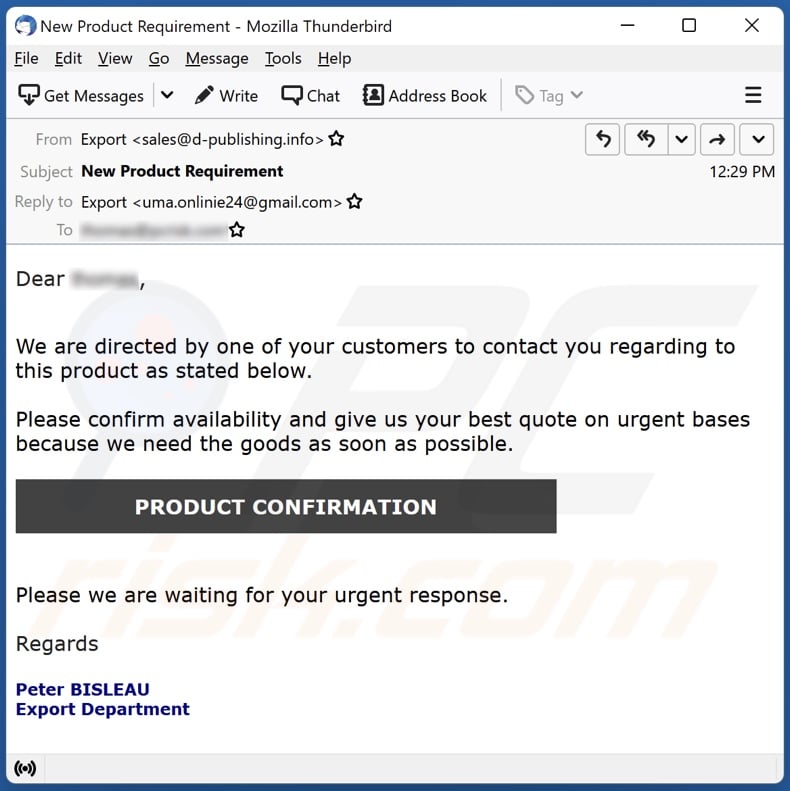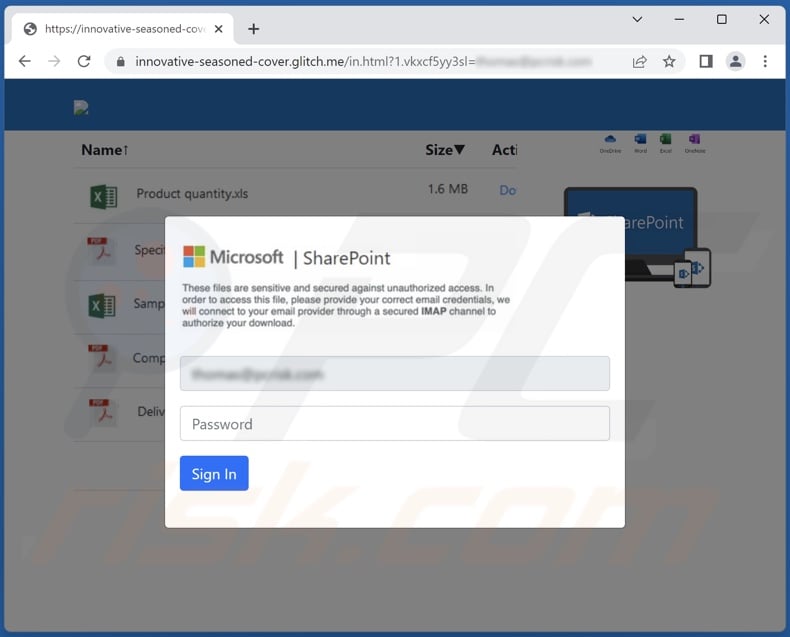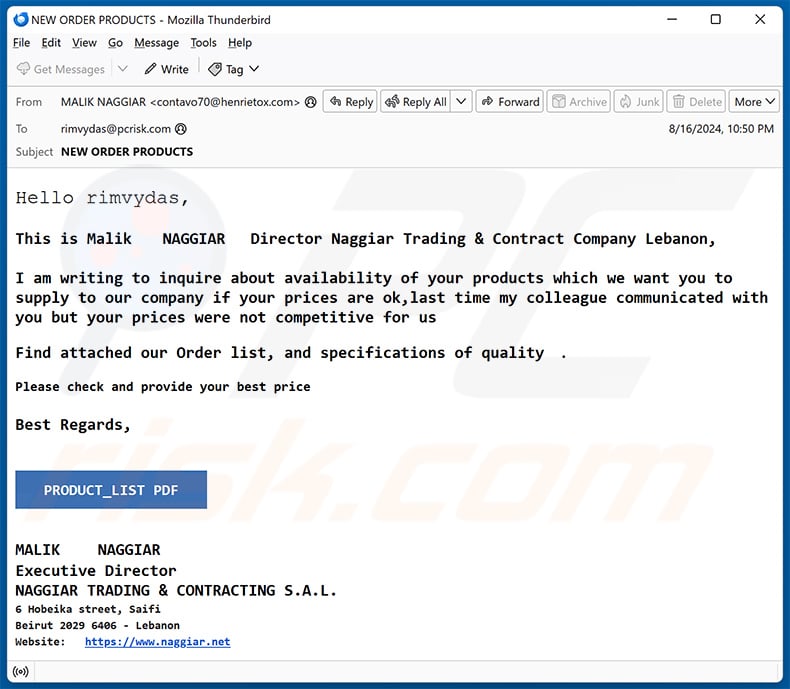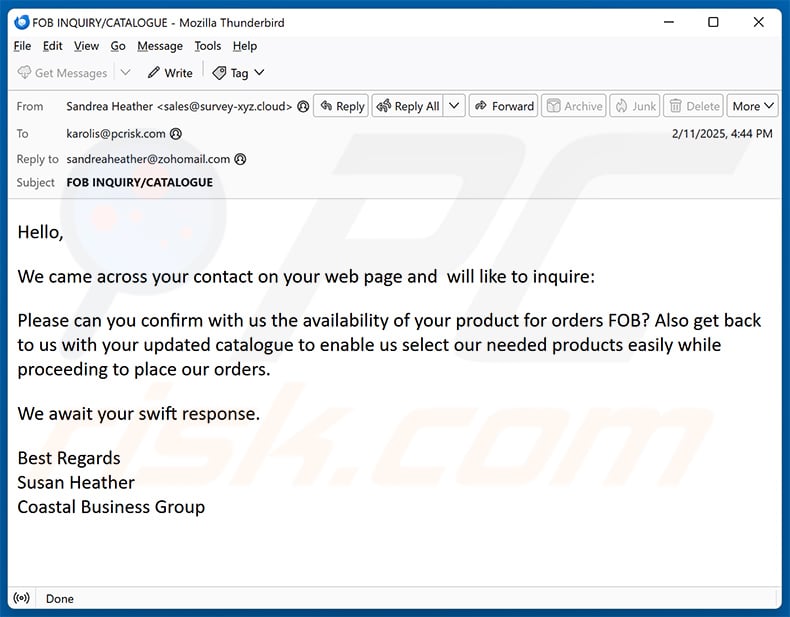Do not trust the "Product Availability Confirmation" phishing email
Phishing/ScamAlso Known As: "Product Availability Confirmation" phishing email
Get free scan and check if your device is infected.
Remove it nowTo use full-featured product, you have to purchase a license for Combo Cleaner. Seven days free trial available. Combo Cleaner is owned and operated by RCS LT, the parent company of PCRisk.com.
What kind of email is "Product Availability Confirmation"?
After inspecting the "Product Availability Confirmation" email, we learned that it is spam. The fake letter is presented as an urgent purchase request from the sender. This mail operates as a phishing scam and promotes a phishing site disguised as SharePoint. This website is designed to record and steal provided email account passwords.

"Product Availability Confirmation" email scam overview
The scam email with the subject "New Product Requirement" (may vary) states that the sender has been redirected to the recipient by the latter's past customer. The letter requests the recipient to urgently confirm their product's availability and provide the best quote.
As previously mentioned, all this information is false. Therefore, when we clicked the "PRODUCT CONFIRMATION" button, we were redirected to a phishing website. This page is disguised as the SharePoint Web-based collaborative platform that has Microsoft Office integrated into it.
This bogus page stated – "These files are sensitive and secured against unauthorized access. In order to access this file, please provide your correct email credentials, we will connect to your email provider through a secured IMAP channel to authorize your download". The email account credentials (i.e., email address and corresponding password) entered into this webpage will be recorded and sent to the cyber criminals behind this spam campaign.
In addition to stealing the exposed emails, the criminals may also hijack the content registered through them. To elaborate, stolen finance-related accounts (e.g., online banking, e-commerce, digital wallets, etc.) can be used to make fraudulent transactions and online purchases.
Scammers can also assume the identities of social account owners (e.g., emails, social networking, messengers, etc.) and ask the contacts/friends/followers for loans or donations, promote scams, and proliferate malware by sharing malicious files/links.
To summarize, by trusting an email like "Product Availability Confirmation" – users can experience system infections, serious privacy issues, financial losses, and identity theft.
If you have disclosed your log-in credentials – change the passwords of all possibly exposed accounts and contact your official support without delay.
| Name | "Product Availability Confirmation" phishing email |
| Threat Type | Phishing, Scam, Social Engineering, Fraud |
| Fake Claim | Recipient is requested to confirm product availability and provide the best quote. |
| Symptoms | Unauthorized online purchases, changed online account passwords, identity theft, illegal access of the computer. |
| Distribution methods | Deceptive emails, rogue online pop-up ads, search engine poisoning techniques, misspelled domains. |
| Damage | Loss of sensitive private information, monetary loss, identity theft. |
| Malware Removal (Windows) |
To eliminate possible malware infections, scan your computer with legitimate antivirus software. Our security researchers recommend using Combo Cleaner. Download Combo CleanerTo use full-featured product, you have to purchase a license for Combo Cleaner. 7 days free trial available. Combo Cleaner is owned and operated by RCS LT, the parent company of PCRisk.com. |
Phishing spam campaign examples
We have inspected thousands of spam emails; "Measures To Strengthen Server Security", "Incoming Mails Have Been Restricted", "Documents Inquiry", and "ACCOUNT SHUT-DOWN" are just some examples of our newest finds of letters that operate as phishing scams.
It must be mentioned that spam mail is also used to distribute trojans, ransomware, cryptocurrency miners, and other malware.
Due to how widespread and well-made this mail can be – we strongly recommend exercising caution with incoming emails, PMs/DMs, SMSes, and other messages.
How do spam campaigns infect computers?
Spam campaigns proliferate malware by distributing malicious files as attachments and links. These files can be in various formats, e.g., documents (Microsoft Office, Microsoft OneNote, PDF, etc.), archives (RAR, ZIP, etc.), executables (.exe, .run, etc.), JavaScript, and so forth.
When a virulent file is executed, run, or otherwise opened – malware download/installation is triggered. For example, Microsoft Office documents infect devices by executing malicious macro commands, while infectious Microsoft OneNote files need users to click on embedded content.
How to avoid installation of malware?
We strongly advise being careful with incoming emails and other messages. The attachments and links found in suspicious mail must not be opened, as they can be virulent. We recommend using Microsoft Office versions released after 2010 since they have the "Protected View" mode that prevents automatic macro command execution.
However, it must be mentioned that malware is not spread only through spam mail. Therefore, we also advise downloading from official and verified channels. Furthermore, all programs must be activated and updated using functions/tools provided by legitimate developers, as illegal activation tools ("cracks") and third-party updaters can contain malware.
Another recommendation is to be vigilant when browsing since fraudulent and malicious content usually appears harmless.
We must stress the importance of having a dependable anti-virus installed and kept up-to-date. Security software must be used to run regular system scans and to remove detected threats. If you've already opened malicious attachments, we recommend running a scan with Combo Cleaner Antivirus for Windows to automatically eliminate infiltrated malware.
Text presented in the "Product Availability Confirmation" spam email letter:
Subject: New Product Requirement
Dear -,
We are directed by one of your customers to contact you regarding to this product as stated below.
Please confirm availability and give us your best quote on urgent bases because we need the goods as soon as possible.
PRODUCT CONFIRMATION
Please we are waiting for your urgent response.
Regards
Peter BISLEAU
Export Department
Screenshot of the phishing website promoted by the "Product Availability Confirmation" spam campaign:

Other examples of emails from "Product Availability Confirmation" spam campaign:
Sample 1:

Text presented within:
Subject: NEW ORDER PRODUCTS
Hello -,
This is Malik NAGGIAR Director Naggiar Trading & Contract Company Lebanon,
I am writing to inquire about availability of your products which we want you to supply to our company if your prices are ok,last time my colleague communicated with you but your prices were not competitive for us
Find attached our Order list, and specifications of quality .
Please check and provide your best price
Best Regards,
PRODUCT_LIST PDF
MALIK NAGGIAR
Executive Director
NAGGIAR TRADING & CONTRACTING S.A.L.
6 Hobeika street, Saifi
Beirut 2029 6406 - Lebanon
Website: -
Sample 2:

Text presented within:
Subject: FOB INQUIRY/CATALOGUE
Hello,We came across your contact on your web page and will like to inquire:
Please can you confirm with us the availability of your product for orders FOB? Also get back to us with your updated catalogue to enable us select our needed products easily while proceeding to place our orders.
We await your swift response.
Best Regards
Susan Heather
Coastal Business Group
Instant automatic malware removal:
Manual threat removal might be a lengthy and complicated process that requires advanced IT skills. Combo Cleaner is a professional automatic malware removal tool that is recommended to get rid of malware. Download it by clicking the button below:
DOWNLOAD Combo CleanerBy downloading any software listed on this website you agree to our Privacy Policy and Terms of Use. To use full-featured product, you have to purchase a license for Combo Cleaner. 7 days free trial available. Combo Cleaner is owned and operated by RCS LT, the parent company of PCRisk.com.
Quick menu:
- What is "Product Availability Confirmation" phishing email?
- Types of malicious emails.
- How to spot a malicious email?
- What to do if you fell for an email scam?
Types of malicious emails:
![]() Phishing Emails
Phishing Emails
Most commonly, cybercriminals use deceptive emails to trick Internet users into giving away their sensitive private information, for example, login information for various online services, email accounts, or online banking information.
Such attacks are called phishing. In a phishing attack, cybercriminals usually send an email message with some popular service logo (for example, Microsoft, DHL, Amazon, Netflix), create urgency (wrong shipping address, expired password, etc.), and place a link which they hope their potential victims will click on.
After clicking the link presented in such email message, victims are redirected to a fake website that looks identical or extremely similar to the original one. Victims are then asked to enter their password, credit card details, or some other information that gets stolen by cybercriminals.
![]() Emails with Malicious Attachments
Emails with Malicious Attachments
Another popular attack vector is email spam with malicious attachments that infect users' computers with malware. Malicious attachments usually carry trojans that are capable of stealing passwords, banking information, and other sensitive information.
In such attacks, cybercriminals' main goal is to trick their potential victims into opening an infected email attachment. To achieve this goal, email messages usually talk about recently received invoices, faxes, or voice messages.
If a potential victim falls for the lure and opens the attachment, their computers get infected, and cybercriminals can collect a lot of sensitive information.
While it's a more complicated method to steal personal information (spam filters and antivirus programs usually detect such attempts), if successful, cybercriminals can get a much wider array of data and can collect information for a long period of time.
![]() Sextortion Emails
Sextortion Emails
This is a type of phishing. In this case, users receive an email claiming that a cybercriminal could access the webcam of the potential victim and has a video recording of one's masturbation.
To get rid of the video, victims are asked to pay a ransom (usually using Bitcoin or another cryptocurrency). Nevertheless, all of these claims are false - users who receive such emails should ignore and delete them.
How to spot a malicious email?
While cyber criminals try to make their lure emails look trustworthy, here are some things that you should look for when trying to spot a phishing email:
- Check the sender's ("from") email address: Hover your mouse over the "from" address and check if it's legitimate. For example, if you received an email from Microsoft, be sure to check if the email address is @microsoft.com and not something suspicious like @m1crosoft.com, @microsfot.com, @account-security-noreply.com, etc.
- Check for generic greetings: If the greeting in the email is "Dear user", "Dear @youremail.com", "Dear valued customer", this should raise suspiciousness. Most commonly, companies call you by your name. Lack of this information could signal a phishing attempt.
- Check the links in the email: Hover your mouse over the link presented in the email, if the link that appears seems suspicious, don't click it. For example, if you received an email from Microsoft and the link in the email shows that it will go to firebasestorage.googleapis.com/v0... you shouldn't trust it. It's best not to click any links in the emails but to visit the company website that sent you the email in the first place.
- Don't blindly trust email attachments: Most commonly, legitimate companies will ask you to log in to their website and to view any documents there; if you received an email with an attachment, it's a good idea to scan it with an antivirus application. Infected email attachments are a common attack vector used by cybercriminals.
To minimise the risk of opening phishing and malicious emails we recommend using Combo Cleaner Antivirus for Windows.
Example of a spam email:

What to do if you fell for an email scam?
- If you clicked on a link in a phishing email and entered your password - be sure to change your password as soon as possible. Usually, cybercriminals collect stolen credentials and then sell them to other groups that use them for malicious purposes. If you change your password in a timely manner, there's a chance that criminals won't have enough time to do any damage.
- If you entered your credit card information - contact your bank as soon as possible and explain the situation. There's a good chance that you will need to cancel your compromised credit card and get a new one.
- If you see any signs of identity theft - you should immediately contact the Federal Trade Commission. This institution will collect information about your situation and create a personal recovery plan.
- If you opened a malicious attachment - your computer is probably infected, you should scan it with a reputable antivirus application. For this purpose, we recommend using Combo Cleaner Antivirus for Windows.
- Help other Internet users - report phishing emails to Anti-Phishing Working Group, FBI’s Internet Crime Complaint Center, National Fraud Information Center and U.S. Department of Justice.
Frequently Asked Questions (FAQ)
Why did I receive this email?
Spam emails are not personal. These letters are distributed in massive campaigns – hence, thousands of users receive identical messages.
I have provided my personal information when tricked by this spam email, what should I do?
If you have provided account credentials – change the credentials of all potentially exposed accounts and inform their official support without delay. And if you've disclosed other private data (e.g., ID card details, credit card numbers, etc.) – immediately contact the appropriate authorities.
I have read a spam email but didn't open the attachment, is my computer infected?
No, merely opening an email will not result in a system infection. Malware download/installation processes are triggered when malicious attachments/links are opened.
I have downloaded and opened a file attached to a spam email, is my computer infected?
If the opened file was an executable (.exe, .run, etc.) – most likely, yes – your device was infected. However, you might have avoided an infection if it was a document (.doc, .xls, .one, .pdf, etc.). These formats may require additional interaction (e.g., enabling macro commands, clicking on embedded content, etc.) to begin downloading/installing malware.
Will Combo Cleaner remove malware infections present in email attachments?
Yes, Combo Cleaner is designed to detect and eliminate threats. It can remove practically all known malware infections. Keep in mind that since sophisticated malicious software usually hides deep within systems – running a complete system scan is essential.
Share:

Tomas Meskauskas
Expert security researcher, professional malware analyst
I am passionate about computer security and technology. I have an experience of over 10 years working in various companies related to computer technical issue solving and Internet security. I have been working as an author and editor for pcrisk.com since 2010. Follow me on Twitter and LinkedIn to stay informed about the latest online security threats.
PCrisk security portal is brought by a company RCS LT.
Joined forces of security researchers help educate computer users about the latest online security threats. More information about the company RCS LT.
Our malware removal guides are free. However, if you want to support us you can send us a donation.
DonatePCrisk security portal is brought by a company RCS LT.
Joined forces of security researchers help educate computer users about the latest online security threats. More information about the company RCS LT.
Our malware removal guides are free. However, if you want to support us you can send us a donation.
Donate
▼ Show Discussion